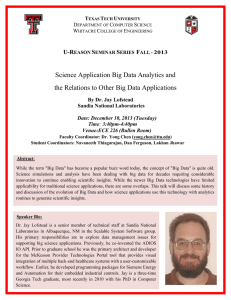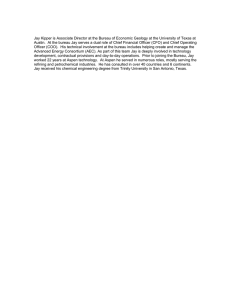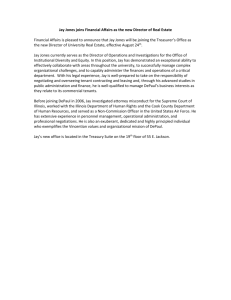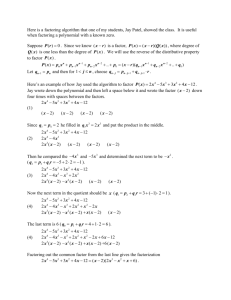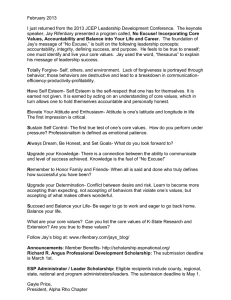25 107 Introduction to 25.107 Introduction to Engineering for ECE
advertisement
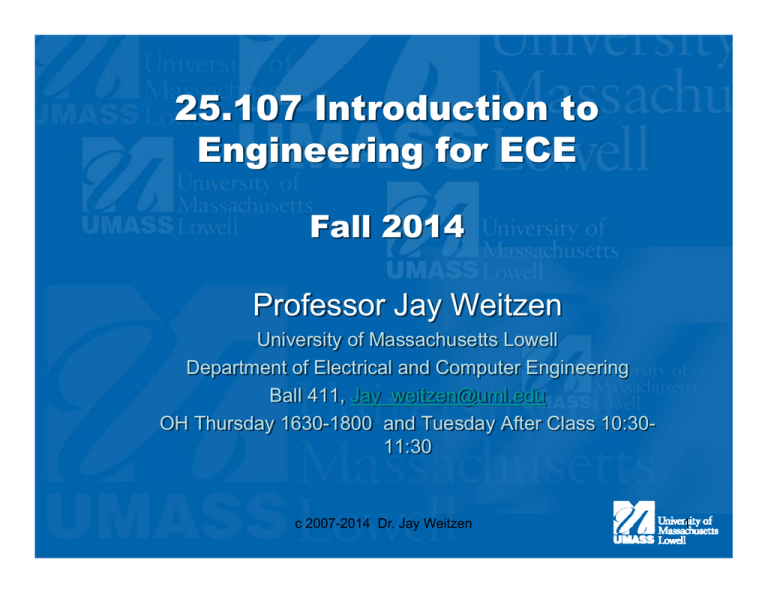
25.107 25 107 Introduction to Engineering for ECE Fall 2014 Professor Jay Weitzen University U i it off M Massachusetts h tt L Lowellll Department of Electrical and Computer Engineering Ball 411, Jay_weitzen@uml.edu OH Thursday 1630-1800 and Tuesday After Class 10:3011:30 c 2007-2014 Dr. Jay Weitzen 1 Official Course Web Site • http://faculty.uml.edu/jweitzen • Please Pl check h k the th website b it week k ffor announcements, course materials etc. • All materials t i l will ill be b distributed di t ib t d via i the th Web W b site. c 2007-2014 Dr. Jay Weitzen 2 Overview • • • • • What are we going to cover ? How will you be graded? Why should you take this course? How to get the most out of this class? Introduction to Good Programming! c 2007-2014 Dr. Jay Weitzen 4 What are we going to cover ? • Application Programming in Matlab (7 weeks) – – – – • Learn Basic Programming Skills See Examples of Digital Signal Processing Help Strengthen your math and problem solving skills Learn Basics of Analysis of Data ECE Lab in a Box (6 weeks) – Learn Analog Devices “Lab Lab in a Box” Box digital oscilloscope and function generator – Write Simple Programs on a C micro-controller to make lights blink, control servos, read sensors, make sounds – Play with basic electronic components, learn to breadboard – Learn design through open ended design projects c 2007-2014 Dr. Jay Weitzen 5 Grading Policy • • • • 4 Regular Matlab Exercises 2 Special Matlab Exercises 6 ECE Hdw/Sw Labs Attendance • Attendance at 7 Lectures is required. (Lab Attendance will be factored into the final grade) Late Lab Reports are 20% loss per week late starting at the end of lab 1 week after assignment All L Labs b mustt b be completed l t d and d submitted b itt d for f grade d off A or AA Be aware: We are going to be very picky about good programming techniques, and things like axis titles and d descriptions, i ti comments, t variable i bl naming, i bl block k iindenting, d ti etc. t • • • 24% 30% 36% 10% c 2007-2014 Dr. Jay Weitzen 6 My Course Expectations!!! • Have Fun! – If what we do in this class is not fun for you, consider whether this is the right major. • COME TO LAB PREPARED – Attend or watch Lab Lectures – Read Lab Exercises and materials in Advance – Stay Caught UP, it is your responsibility • Do your Best – Get Help if you Need it • What Wh t you hand h d iin should h ld llook k professional f i l c 2007-2014 Dr. Jay Weitzen 7 ORDERING YOUR OWN Lab In Th B The Box • You need to order your own Lab-In-A-Box kit • – URL is on website – You need it by 10/21/2014: Don’t Wait Order Now! – Software Available Free on the Website Contents of Lab in a Box: – Analog Devices Discovery Module • • • • Oscilloscope Function Generator Logic Analyzer Volt Meter – Arduino Uno 32 Microcontroller – Wire Kit – Proto P t Board B d • Parts kit (given out on first day of Hardware Labs) c 2007-2014 Dr. Jay Weitzen 8 Your UML ECE “Lab Lab In a Box Box” Course Parts Kit and Wire Kit Digilent/Analog Di il t/A l Devices Discovery Kit: •2 Channel Digital Oscilloscope •Waveform Generator •Logic Analyzer •Volt meter Arduino Micro Controller Textbook and References Matlab Textbook is free on Website to save you money Optional Text available in bookstore Reference For Microcontroller: See Website Other References : Lecture Notes, Online Help c 2007-2014 Dr. Jay Weitzen 10 Why y this course • Matlab is used in many upcoming courses. • This Thi course builds b ild your analytical l ti l and d problem bl solving l i skills in preparation for circuits, signal processing, communications, and control disciplines. • Give you a first C programming experience in advance of 16.216 • Learn to use a digital oscilloscope, oscilloscope function generator • Learn basic Electronic Components such as resistors, capacitors and basic assembly and test techniques • Understand U d t d interfacing i t f i software ft and d hardware h d b based d systems c 2007-2014 Dr. Jay Weitzen 11 Getting Help • See your TA in Lab or in office hours • Come see me in office hours • Make an appointment with me – (I really don’t bite and am here to help you ) • Send an e e-mail mail to me • Talk to your peers, but be careful, they may be even more lost than you are! c 2007-2014 Dr. Jay Weitzen 12 How to get the most out of this class! • Come to the lectures or watch them on video. I will give g you useful hints for solving the week’s problem – Download the notes and annotate them • Please be prepared for lab by reviewing the lab and l lecture notes before b f coming i to lab. l b • • – Ask questions, that is why your TA’s are there Read the Reference Materials for each week’s labs Ch k the Check th Course C W b it each Website h week k for f hi t and hints d important i t t updates. – If Classes are cancelled go to the website for instructions. • Come and see me if you have questions, are stuck, or just want to talk. – If you have spent 2 hours in lab and 2 more hours stuck, please stop and come see me. c 2007-2014 Dr. Jay Weitzen 13 Course Logistics • One hour of lecture on Tuesday and two hours of lab each week are for ECE – Each Week there will be assigned readings • ALL LABS meet in E-321 Freshman Engineering Lab – Lab attendance is required and counts towards your grade. grade – At your scheduled time, you get priority on a seat: You are welcome at other times as space permits. • If you want an A or AA you need to complete and submit all lab exercises • To purchase student edition of Matlab go to ( (www.mathworks.com) th k ) c 2007-2014 Dr. Jay Weitzen 14 Assignment for Lab This Week • Go to Laboratory: E-321 • Download and read Lecture Notes 0 and 1 • Do Exercise 0 and submit to your TA. Answers included c 2007-2014 Dr. Jay Weitzen 15 Professor Jay Weitzen (that’s me)) • EDUCATIONAL & PROFESSIONAL EXPERIENCE: – Education: • Ph.D. University of Wisconsin, Madison, 1983 • MSEE Universityy of Wisconsin, Madison, 1979 • BSEE University of Wisconsin, Madison, 1978 – Professional Experience: • More than 30 Years of Industrial and Academic experience in wireless i l networks, k radio di propagation, i wireless i l network kd design. i 2 US patents, and approximately 100 publications in the open literature in areas of modern wireless systems. – Current Research Interests: • Performance of large wireless 3G and 4G networks, small cell networks, high speed wireless data networks, network planning, wireless position location and applications, radio propagation c 2007-2014 Dr. Jay Weitzen 16 LEARNING TO PROGRAM c 2007-2014 Dr. Jay Weitzen 17 How to write a program p g • Start with the requirements. What is the program supposed to do? – No point running fast if you do not know where you are going • What are the external interfaces (inputs and outputs) p ) • What is the algorithm, describe it in pseudo-code or English • Turn the algorithm into real code e e.g. g Matlab – Don’t forget to add comments, and good naming conventions • Test, validate, and debug. – Spend less time here, more at beginning c 2007-2014 Dr. Jay Weitzen 18 Some Comments on good P Programming! i ! • Stream of consciousness programming usually gets you in trouble – Understand clearly what you want to do before you start to program, program and it will usually work • Programming can be addicting like a video game – If you are stuck, do not keep doing the same thing over and over again (you will get same results) • Step back and understand what you are trying to do • Single step your program with the real time debugger • Test all Code paths including error handling c 2007-2014 Dr. Jay Weitzen 19 End of Notes 0: Good Luck c 2007-2014 Dr. Jay Weitzen 20
